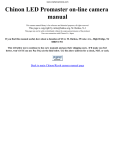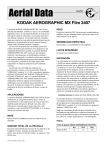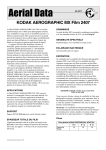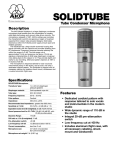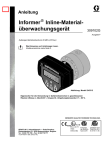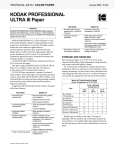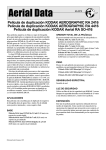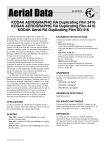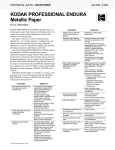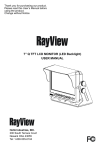Download Kodak 2403 User's Manual
Transcript
AS-24 KODAK TRI-X AEROGRAPHIC Film 2403 KODAK TRI-X AERECON Film SO-050 KODAK TRI-X AEROGRAPHIC Film 2403 and KODAK TRI-X AERECON Film SO-050 are panchromatic, negative aerial camera films that have high speed, moderate contrast, and extended red sensitivity for the reduction of haze effects. The photographic properties of these two films are virtually identical; the physical properties differ due to the difference in base thickness. Their ESTAR Base and ESTAR Thin Base provide flexibility, moisture resistance, high tear resistance, and excellent dimensional stability. These films have highly hardened emulsions which provide high acutance, or improved image sharpness, and permit high-temperature rapid processing in modern continuous processing machines. These films can be processed in the KODAK VERSAMAT Film Processor, Model 11 or 1140, with KODAK VERSAMAT 885 Chemicals, KODAK VERSAMAT 641 Chemicals, or KODAK VERSAMAT Chemicals, Type A. KODAK TRI-X AEROGRAPHIC Film 2403 can also be processed at normal temperatures in conventional rewind equipment, such as the Gordon/Morse M-10 Developing Outfit (Military Designator: B-5) using a variety of Kodak black-and-white developers. Caution: KODAK TRI-X AEROGRAPHIC and AERECON Films are susceptible to static markings at low relative humidities. These films are packaged at the optimum relative humidity (45 to 50 percent) and are maintained at this level by the sealed package. In conditions of low relative humidity, these films should be loaded and used immediately after the package is opened, before the film becomes too dry. The camera should be checked to see that all its parts are grounded adequately. Also, these films should be handled carefully during all loading, unloading, and preprocessing operations. APPLICATIONS KODAK TRI-X AEROGRAPHIC Film 2403 is a high-speed film for use in low-altitude, large-scale aerial mapping for photogrammetry, or in mapping at low light levels caused by low solar altitudes. KODAK TRI-X AERECON Film SO-050 is suitable for reconnaissance under minimum levels of illumination. BASE 2403 Film: 3.9-mil (0.10 mm) ESTAR Base with dyed-gel backing SO-050 Film: 2.5-mil (0.063 mm) ESTAR Thin Base with dyed-gel backing TOTAL FILM THICKNESS The nominal total thickness (unprocessed) of each film is: 2403 Film: 4.55 mils (0.115 mm) This includes emulsion—0.45 mils (0.010 mm), base— 3.9 mils (0.10 mm) and dyed-gel backing—0.20 mil (0.005 mm). SO-050 Film: 3.15 mils (0.080 mm) This includes emulsion—0.45 mils (0.011 mm), base— 2.5 mils (0.063 mm) and dyed-gel backing—0.20 mil (0.005 mm). WEIGHT The weight of each film (unprocessed), conditioned in equilibrium with 50 percent relative humidity, is: 2403 Film: 0.037 lbs⁄sq ft2 (0.0168 kg⁄ft2) SO-050 Film: 0.021 lbs⁄sq ft2 (0.0095 kg⁄ft2) SPECTRAL SENSITIVITY Panchromatic, with extended red sensitivity. SAFELIGHT Total darkness is required. ©Eastman Kodak Company, 2000 EXPOSURE IMAGE STRUCTURE Aerial film speeds (ISO A or EAFS) should not be confused with conventional film speeds which are designed for roll and sheet films used in pictorial photography. The characteristics of aerial scenes differ markedly from those of ordinary pictorial or ground scenes because of the smaller range in subject luminances, atmospheric haze conditions, and other factors. Therefore, different film-speed parameters are used to relate aerial-scene characteristics to practical exposure recommendations. The KODAK Aerial Exposure Computer, KODAK Publication AS-10 has been published based on the aerial film speed criterion. Nominal speed, daylight (no filter): EAFS or ISO A 500 The following data are based on processing in a KODAK VERSAMAT Film Processor using KODAK VERSAMAT Chemicals. Other suggested aerial film speeds for processing these films in the KODAK VERSAMAT Film Processor, Models 11 or 1140, using VERSAMAT 885 Chemicals, 641 Chemicals, and Type A Chemicals can be found in the sensitometric data tables. Note: The aerial film speeds given in this publication were obtained by rounding the calculated values to the nearest cube root of 2 step (equivalent to 1⁄3 stop). Filters KODAK PROFESSIONAL WRATTEN Gelatin Filter No. 12 No. 25 1.5 3 Filter Factor Typical Camera Exposure A typical exposure for this film is approximately 1⁄400 second at f⁄8. This exposure is based on a solar altitude of 5 degrees, a clear day, an aircraft altitude of 5,000 feet, and a speed of ISO A 640 (no filter). When using an aerial camera equipped with an antivignetting filter, or other filter, it is important to increase this typical exposure by the filter factor of the filter used. Reciprocity Characteristics No exposure or development time adjustments are required for exposure times from 1,000 second to 1⁄10 second. At 1⁄10,000 second, increase the development time by 10 percent. Resolving Power (line pairs/mm) TOC 1.6:1 TOC 1000:1 rms Granularity* VERSAMAT Model 11 885 Chemicals† 40 100 40 Chemicals‡ 25 100 33 Type A Chemicals§ 32 80 55 40 100 33 641 VERSAMAT Model 1140 885 Chemicals¶ * Granularity values read at a net diffuse density of 1.0 with a 48-micrometre aperture. 885--2 racks, 10 fpm, 85°F (29.5°C), process gamma 1.40 ‡ 641--2 racks, 6.5 fpm, 85°F (29.5°C), process gamma 1.25 § Type A--2 racks, 10 fpm, 90°F (32°C), process gamma 1.70 ¶ 885--1 rack, 15 fpm, 99°F (37°C), process gamma 0.95 † STORAGE For consistent results, all aerial films should be stored under fairly constant conditions. Kodak aerial films are “usually” packaged in equilibrium with 40 to 50 percent relative humidity. High temperatures or high humidity may produce undesirable changes in the film. Unexposed Film Store unexposed film in a refrigerator at 55°F (13°C) or lower, or freezer at 0 to -10°F (-18 to -23°C), in the original sealed container. If the film is stored in a refrigerator, remove it about 2 hours before opening; if stored in a freezer, remove it about 8 hours before opening. A sufficient warm-up time is necessary to prevent moisture condensation on cold film— otherwise, moisture spotting, ferrotyping, or sticking may occur. Exposed Film Keep exposed film cool and dry. Process the film as soon as possible after exposure to avoid undesirable changes in the latent image. If it is necessary to hold exposed but unprocessed film for several days (such as over a weekend), it should be resealed and refrigerated at 40°F (4°C) or lower. Before unsealing and processing exposed film that has been held in cold storage, follow the warm-up procedures described for unexposed film described above. Processed Film For best keeping, store processed film in a dark, dust-free area at 50 to 70°F (10 to 21°C) and 30 to 50 percent relative humidity. Preferably, store negatives on the spool or in individual KODAK Sleeves. High relative humidity promotes the growth of mold and causes ferrotyping. Very low relative humidity causes excessive curl and brittleness. Avoid storage temperatures over 80°F (27°C). 2 KODAK TRI-X AEROGRAPHIC Film 2403 KODAK TRI-X AERECON Film SO-050 • AS-24 PROCESSING Replenishment Rates KODAK TRI-X AEROGRAPHIC and AERECON Films can be processed in the KODAK VERSAMAT Film Processor, Model 11 or 1140, with KODAK VERSAMAT 885 Chemicals, KODAK VERSAMAT 641 Chemicals, or KODAK VERSAMAT Chemicals, Type A. Mechanized processing in roller-transport processors offers the advantages of uniform treatment of all portions of the roll, freedom from banding, and absence of significant density variations from ends of the roll to the center. Refer to the operator’s manual for the processor set-up information, but in all cases, the fixer replenisher should be introduced into tank No. 5 of the processor with a countercurrent flow to tank No. 3, where it overflows to a collection or recovery system. General instructions for setting the machine dryer temperature are included in these pages. However, the temperature of the dryer may require some further adjustment, depending upon the ambient temperature conditions in the processing area. Usually it is best to set the temperature approximately 3°F (2°C) above that required to dry unexposed, processed film. Basic developer and fixer replenishment rates, in millilitres per square inch of film processed, vary depending upon the type of chemicals used. The following rates apply to processing in the VERSAMAT Processor, Models 11 and 1140. Chemicals The following KODAK VERSAMAT Chemicals may be used in both the Model 11 and Model 1140 VERSAMAT Processors. KODAK VERSAMAT 885 Developer Starter KODAK VERSAMAT 885 Developer Replenisher Basic Replenishment Rates (mL/in2) KODAK VERSAMAT Chemicals 885 641 Type A Developer 0.36 0.34 0.20 Fixer 0.45 0.68 0.34 Processing Sequence KODAK VERSAMAT Processor, Model 11 (all recommended chemicals) Processing No. of Step Racks Path Length Temperature 1 or 2 1.2 or 2.4 m (4 or 8 ft) 85 ± 0.5°F (29.5 ± 0.3°C) Fix 3 3.6 m (12 ft) 85°F (29.5°C), nominal Wash 2 2.4 m (8 ft) 2 to 6°F (1 to 3°C) below developer temperature Dry — 2.4 m (8 ft) 135 to 145°F (57 to 63°C) Develop* *For KODAK VERSAMAT Chemicals, Type A, use 90°F (32°C). Sensitometric Data KODAK VERSAMAT 885 Fixer and Replenisher KODAK VERSAMAT 641 Developer Starter KODAK VERSAMAT 641 Developer Replenisher KODAK VERSAMAT 885 Chemicals, Model 11 1 Developer Rack 2 Developer Racks Machine Speed Average Average ISO A D-min ISO A D-min (fpm) Gamma Gamma KODAK VERSAMAT 641 Fixer and Replenisher 85°F (29.5°C) KODAK VERSAMAT Developer Starter, Type A 5 1.10 640 0.21 1.80 800 0.28 KODAK VERSAMAT Developer Replenisher, Type A 10 0.70 400 0.14 1.40 640 0.15 KODAK VERSAMAT Fixer and Replenisher, Type A 15 0.55 250 0.13 1.10 640 0.12 20 0.41 125 0.13 0.95 500 0.12 25 0.36 100 0.12 0.80 400 0.12 Notice: Observe precautionary information on product labels and Material Safety Data Sheets. Fixing: Adequate fixing is obtained at machine speeds up to and including 20 feet per minute. Washing: With two developer racks, LE-100 keeping quality is obtained at process machine speeds up to 10 feet per minute, and LE-10 is obtained up to and including 20 feet per minute. (LE = Life Expectancy) Drying: Adequate drying is obtained at machine speeds up to and including 15 feet per minute. KODAK TRI-X AEROGRAPHIC Film 2403 KODAK TRI-X AERECON Film SO-050 • AS-24 3 Processing Sequence KODAK VERSAMAT 641 Chemicals, Model 11 1 Developer Rack 2 Developer Racks Machine Speed Average Average ISO A D-min ISO A D-min (fpm) Gamma Gamma 85°F (29.5°C) 5 0.80 400 0.15 1.15 640 0.17 10 0.55 160 0.14 0.85 400 0.15 15 — — — 0.65 250 0.34 Fixing: Adequate fixing is obtained at machine speeds up to and including 10 feet per minute. Washing: LE-100 keeping quality is obtained at process machine speeds up to and including 5 feet per minute. (LE = Life Expectancy) Drying: Adequate drying is obtained at machine speeds up to and including 20 feet per minute. KODAK VERSAMAT Chemicals, Type A, Model 11 1 Developer Rack 2 Developer Racks Machine Speed Average Average ISO A D-min ISO A D-min (fpm) Gamma Gamma 90°F (32°C) KODAK VERSAMAT Processor, Model 1140 (all recommended chemicals) Processing No. of Step Racks Path Length Temperature 1 or 2 1.2 or 2.4 m (4 or 8 ft) 99 or 104 ± 0.5°F (37 or 40 ± 0.3°C) Fix 3 3.6 m (12 ft) 99 or 104°F (37 or 40°C), nominal Wash 2 2.4 m (8 ft) 2 to 6°F (1 to 3°C) below developer temperature Dry — 2.4 m (8 ft) Up to 149°F (65°C) Develop Sensitometric Data KODAK VERSAMAT 885 Chemicals, Model 1140 1 Developer Rack 2 Developer Racks Machine Speed Average Average ISO A D-min ISO A D-min (fpm) Gamma Gamma 99°F (37°C) 10 0.90 640 0.21 — — — 20 0.65 320 0.16 1.00 640 0.24 5 2.05 1000 0.16 — — — 30 0.45 200 0.12 0.80 500 0.19 10 1.10 500 0.13 1.35 800 0.15 40 0.35 125 0.14 0.70 400 0.18 15 0.95 320 0.13 1.00 500 0.14 20 0.85 250 0.14 0.90 400 0.14 10 1.00 640 0.23 — — — Fixing: Adequate fixing is obtained at machine speeds up to and including 10 feet per minute. 20 0.70 400 0.16 1.15 640 0.22 30 0.50 250 0.15 0.95 640 0.25 Washing: LE-10 keeping quality is obtained at machine speeds up to and including 8 feet per minute. (LE = Life Expectancy) 40 0.45 200 0.13 0.80 500 0.21 Drying: Adequate drying is obtained at machine speeds up to and including 12 feet per minute. 104°F (40°C) KODAK VERSAMAT 641 Chemicals, Model 1140 1 Developer Rack 2 Developer Racks Machine Speed Average Average ISO A D-min ISO A D-min (fpm) Gamma Gamma 99°F (37°C) 10 0.80 400 0.17 1.15 640 0.19 104°F (40°C) 10 0.85 320 0.16 1.30 800 0.21 20 0.55 160 0.22 0.90 500 0.21 KODAK VERSAMAT Chemicals. Type A; Model 1140 This is not a primary processing recommendation, although satisfactory results can be obtained at processor speeds up to 10 feet per minute. Refer to the processing conditions and sensitometric data for the KODAK VERSAMAT Processor, Model 11, above. 4 KODAK TRI-X AEROGRAPHIC Film 2403 KODAK TRI-X AERECON Film SO-050 • AS-24 REWIND OR SPIRAL REEL PROCESSING DIMENSIONAL STABILITY KODAK TRI-X AEROGRAPHIC Film 2403 yields optimum results with modern, high-temperature, continuous-processing machines. It can be processed in rewind equipment or on spiral reels, although these methods are not primary processing recommendations. Customers wishing to use spiral reels or rewind equipment such as the Gordon/Morse M-10 Developing Outfit (Military Designator: B-5) may contact Aerial Systems for information on exposure, processing chemicals, process cycles, and general recommendations. KODAK TRI-X AERECON Film SO-050 is not recommended for processing in conventional rewind equipment due to the physical characteristics of its ESTAR Thin Base. The dimensional stability of aerial films is of particular interest and importance in accurate mapping and in the reproduction of maps. Dimensional stability is an all-inclusive term. In photography, it applies to size changes caused by changes in humidity and in temperature, and by processing and aging. The absence of solvent in ESTAR Base is one of the reasons why ESTAR Base films show excellent dimensional stability. The dimensional properties of ESTAR Base may vary slightly in different directions within a sheet; the differences that may exist, however, are not always between the length and width directions. Temporary Dimensional Changes Thermal Coefficient of Linear Expansion: 2403 SO-050 0.001% 0.001% 0.0018% 0.0018% per degree C of change per degree F of change Humidity Coefficient of Linear Expansion (Unprocessed): 2403 SO-050 0.002% 0.0035% per 1% change in relative humidity Permanent Dimensional Changes Processing Dimensional Change (Shrinkage to Swell): 2403 SO-050 -0.04% to +0.03% -0.04% to +0.03% Aging Shrinkage of Processed Film: 2405 SO-050 0.05% 0.08% 1 week at 120°F (49°C), 20% RH 0.03% 0.04% 1 year at 78°F (25.5°C), 60% RH KODAK TRI-X AEROGRAPHIC Film 2403 KODAK TRI-X AERECON Film SO-050 • AS-24 5 KODAK TRI-X AEROGRAPHIC Film 2403 and KODAK TRI-X AERECON Film SO-050 are available in sizes for certain aerial cameras. Neither film is factory-stocked in any size. Information on minimum order quantities and other sizes of these films is available by writing or calling: Aerial Imaging Eastman Kodak Company Rochester, New York 14653-7128 (716) 253-1855 Note: The Kodak materials described in this publication used with KODAK TRI-X AEROGRAPHIC Film 2403 and KODAK TRI-X AERECON Film SO-050 are available from those dealers normally supplying Kodak products. Other materials may be used, but equivalent results may not be obtained. CURVES Spectral Sensitivity 3.0 Exposure: 1.4 seconds Process: Recommended Densitometry: Diffuse visual D = 0.3 above gross fog 2.0 Log Sensitivity* SIZE DATA AND ORDERING INFORMATION 1.0 D = 1.0 above gross fog 0.0 1.0 400 300 600 500 Wavelength (nm) 700 Modulation Transfer Function 200 100 70 50 RESPONSE (%) 30 20 10 7 5 KODAK VERSAMAT 885 Chemicals KODAK VERSAMAT Film Processor, 2 racks, 85F (29.5C), 10 fpm; Diffuse visual 3 2 1 1 2 3 4 5 10 20 50 100 200 600 SPATIAL FREQUENCY (cycles/mm) F002_1093AC 6 KODAK TRI-X AEROGRAPHIC Film 2403 KODAK TRI-X AERECON Film SO-050 • AS-24 Characterisitc Curves 4.0 Exposure: Daylight 1/100 sec Process: KODAK VERSAMAT 885 Chemicals; KODAK VERSAMAT Film Processor, Model 11; 2 developer racks; 85 °F (29.5°C) Densitometry: Diffuse visual 10000 Aerial Film Speed (ISO A) 3.0 Density ISO A Vs. Gamma 5 fpm 2.0 10 fpm 15 fpm 20 fpm 25 fpm 1.0 Exposure: Daylight 1/100 sec Process: KODAK VERSAMAT Film Processor, Model 11; KODAK VERSAMAT 885 Chemicals; KODAK VERSAMAT 641 Chemicals; 1 and 2 developer rack; 85°F (29.5°C) KODAK VERSAMAT Chemicals, Type A; 1 and 2 developer racks; 90° F (32°C) 1000 Type A Chemicals 885 Chemicals 641 Chemicals 100 0.0 0 3 GAMMA ISO A vs. Machine Speed Gamma vs. Machine Speed 4 800 KODAK VERSAMAT 885 Chemicals, Processor, Model 11, 2 developer racks at 85F (29.5C) KODAK VERSAMAT 885 Chemicals, KODAK VERSAMAT Film Processor, Model 11, 2 developer racks at 85F (29.5C) 750 3 700 650 Gamma Aerial Film Speed (ISO A) 2 1 0 –3 –2 –1 Log Exposure (lux seconds) –4 600 2 550 1 500 450 0 400 0 F002_1105AC 10 20 30 Machine Speed (fpm) 40 50 0 F002_1112AC 10 20 30 40 50 Machine Speed (fpm) KODAK TRI-X AEROGRAPHIC Film 2403 KODAK TRI-X AERECON Film SO-050 • AS-24 7 KODAK TRI-X AEROGRAPHIC Film 2403 KODAK TRI-X AERECON Film SO-050 NOTICE: While the sensitometric data in this publication are typical of production coatings, they do not represent standards which must be met by Kodak. Varying storage, exposure, and processing conditions will affect results. The company reserves the right to change and improve product characteristics at any time. Aerial Imaging EASTMAN KODAK COMPANY • ROCHESTER, NY 14653-7128 KODAK TRI-X AEROGRAPHIC Film 2403 KODAK TRI-X AERECON Film SO-050 KODAK Publication No. AS-24 TI0078 Kodak, Aerecon, Aerographic, Estar, Versamat, Panatomic-X, and Wratten are trademarks Minor Revision 8-01 Printed in U.S.A.








